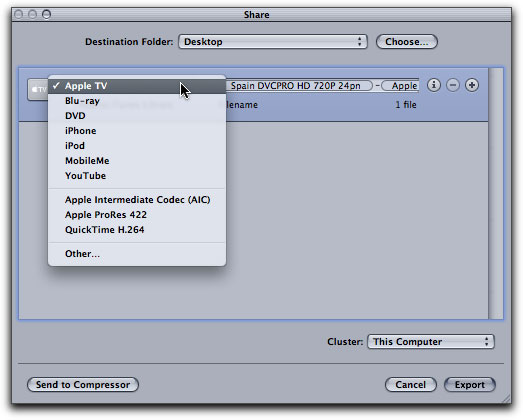

- APPLE COMPRESSOR 3.5 TORRENT FULL
- APPLE COMPRESSOR 3.5 TORRENT PRO
- APPLE COMPRESSOR 3.5 TORRENT OFFLINE
It takes the data rate all the way down to 45 megabits per second for 1080i60 video-or a touch over 5.5 megabytes per second.
APPLE COMPRESSOR 3.5 TORRENT FULL
It is still full frame, 10 bit, and 4:2:2, but is much more heavily compressed.
APPLE COMPRESSOR 3.5 TORRENT OFFLINE
ProRes 422 (Proxy) The other ProRes codecs are fine for online editing (at final quality) for various quality expectations, but what about for offline editing? That’s where ProRes 422 (Proxy) comes in. Sports and news editing for broadcast, for instance, will love this codec, since the decrease in quality will never be noticed by the time is it is compressed even further and sent out to air. It’s the same thing as ProRes (10 bit, full raster, 4:2:2 color sampling), just at a lower data rate, and it’ll fit nicely into existing broadcast infrastructure. So a lot of folks had their digital plumbing set up for 100 megabits per second, and regular ProRes 422, which can run up to 145 megabits per second for 1080i60 footage, could gum up the works since it was nearly 50 percent larger than the anticipated data rate. So why bother? Turns out a lot of broadcast equipment is built around 100 megabits per second pipelines-Panasonic started it with the Varicam and its DV100 (aka DVCPRO HD) codec, and continued with its AVC-Intra codec, both of which run at a maximum data rate of 100 megabits per second. ProRes 422 (LT) If you know the regular ProRes 422, you like it, you use it, then think of this as ProRes 422 on a bandwidth diet. That’s in addition to the two flavors for “normal” editing and finishing-the regular flavor for most projects, and the HQ for higher end quality, which are still included from the previous version. The LT version is for lightweight deliverables, such as broadcast, while the 422 (Proxy) is specifically for offline editing. ProRes 4444 is designed for highest end work or compositing with alpha channel. In the most compelling new feature of this release, Apple builds on the success of its excellent ProRes codec family by adding three new flavors: ProRes 4444, ProRes 422 (LT), and ProRes 422 (Proxy). The new variations are designed to broaden the codec family’s capabilities into higher-end post production, news markets, and offline editing.

APPLE COMPRESSOR 3.5 TORRENT PRO
ProRes, a high-definition lossy video compression format developed by Apple for use in post production, was introduced in 2007 with Final Cut Pro 6 (FCP). While there are a few extremely sexy new features in Final Cut Pro 7- among them new ProRes flavors, iChat Theater, and Easy Export that will attract lots of attention-the main focus of this new version seems to be enhancing stability, speed, and productivity. A few DV/HDV projects that I have possible, I'll just recapture via FCPX or have a friend capture in fcp7 and shoot me the HDD.Īnd for DVD studio pro (now end of life) I can just use Toast Titanium 12 that is finally pretty easy to menu and set up.It has been more than two long years since Apple released Final Cut Pro 6 ( ), its flagship pro-level nonlinear video editing app. That's how the "rough road" began to Premiere Pro then finally to FCPX.Īlso, Compressor was never a real friendly app in my opinion, i never once used motion, and other than DVD Studio Pro which I really really liked, I have no reason for the product. I tried converting the clips before hand, stream clip, transcoding in fcp7, etc and nothing worked. Most of my videos are longer than 5 mins and/or are multicam where FCP7 was always getting the video and audio out of sync when the multicam was about 12 mins or longer and when the single clips were over 15 mins. I can't see any reason I would go back to FCP7 since all my cameras are AVCHD and it just didn't work for me in FCP7. Thanks Russ for the suggestions and the recommendation for FCS Remover.


 0 kommentar(er)
0 kommentar(er)
